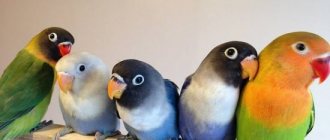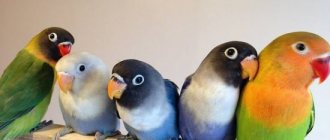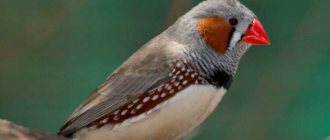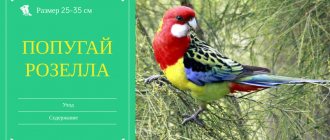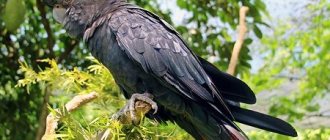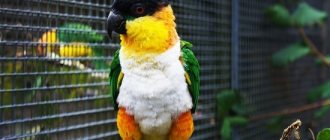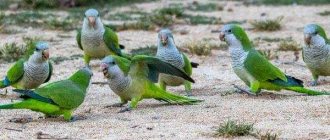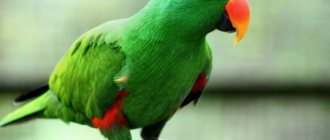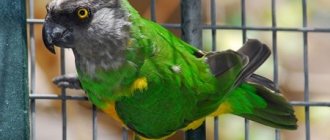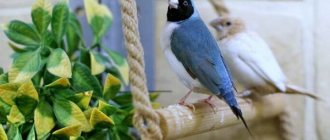Fisher's lovebirds are known for their mischievous nature and love of life. It is impossible to get bored next to these feathered pranksters: they stand out not only in their external features, but also in their habits. Miniature parrots staunchly defend their territory and also know how to be friends with people. Do you want to know why colorful birds are so attractive? Let's first get acquainted with their lifestyle in nature and at home.
Where do Fischer's lovebirds live?
Parrots of this species inhabit southeast Africa, occupying a small territory of Tanzania near Lake Victoria. This area can be considered a good choice for living. On a hot, arid continent, the most valuable thing is fresh water. The presence of a reservoir, as well as a subequatorial climate with rainy seasons, allows birds not to lack food.
Lovebirds do not fly from place to place; they are attached to a specific area. The African savanna suits them: vast plains with small groves. Parrots live in small flocks, united by related origin. As the colony grows, it may break apart. For rest, parrots choose low-growing trees and roost in dense crowns. They feed on ripe fruits, berries, and grass seeds. During periods of drought and lack of food, they are forced to raid farmland.
This is interesting! In nature, lovebirds live in pairs and demonstrate amazing fidelity. In English, their name sounds like “lovebirds” - love birds. They received this nickname due to the manifestation of tender care for each other.
Despite such a small home range, the wild lovebird population contains approximately a million individuals. Once upon a time, during a time of massive demand for exotic birds, their numbers dropped to critical levels. There was a threat of extinction, and the species was going to be listed in the International Red Book. The country's authorities have banned the export of these parrots, thus the situation has leveled out. Birds readily reproduce in captivity, and now it is not advisable to take them from the wild.
general information
Fischer's lovebird occupies one of nine places in the classification. This species of bird was first discovered by the German military doctor Gustav Adolf Fischer while traveling and studying the nature of Africa. Fischer reflected his observations in reports, but soon after his return he died of tropical fever. A few years later, ornithologist Anton Raikhenov published the results of the expedition. Among the birds discovered was a small parrot. The lovebird got its name in honor of the traveler Adolf Fischer.
Masked lovebird (left) and Fischer's lovebird (right)
Fischer's lovebird has a relative similarity to the masked lovebird, so some researchers propose combining the two species into one. But objectively speaking, representatives of the masked subspecies have a striking feature - black plumage on the head, so the division is still justified.
Reproduction
Nests are made in trees. The female tucks tree bark under her tail feathers and thus carries it to the nesting site.
She lays a clutch of three to eight white eggs. Incubation lasts 22-24 days.
The chicks hatch naked and blind. After some time, they become covered with thick orange-red fluff. The legs and skin visible through the fluff are of a bright fleshy color, the beak is light brown. After 11 days, the beak becomes yellow-orange in color and the paws become light brown. After 2 weeks from birth, the fluff acquires a grayish-green tint and feathers begin to show through it.
The chicks leave the nest after 7 weeks, but are fed by their parents for some time.
The average lifespan of Fisher's lovebirds is 15 years, although there is information that one parrot lived to be 32 years old.
Appearance
Among its fellows, Fischer's lovebird is perhaps the smallest - its size does not exceed 17 cm including its tail. An adult bird weighs on average 50 g.
The appearance of the parrot leaves a pleasant impression:
- The eyes are brown, surrounded by white, unfeathered rings.
- Streamlined body shape, the plumage is dense, smooth and shiny.
- The head is round, proportional, there is no noticeable transition to the neck.
- The wings are small and neat - feather to feather.
- The tail is short, blade-shaped.
- The paws are stable, strong and tenacious.
- The beak is quite large, rounded at the top, curved at the tip.
The natural color of a parrot contains three main shades: green, blue, orange. Most of the body is covered with grass-green feathers. The rump is blue, the head is bright fiery. On the chest, orange feathers smoothly give way to yellow ones, creating a kind of “apron”. The crown of some birds is darker than the facial mask. The beak of the chicks is light gray, turning red as they grow.
On a note! Male and female lovebirds are practically indistinguishable in appearance: they have the same color and size. A presumptive conclusion about gender can be made by observing the behavior of birds.
Purchase
Ornamental birds are presented in abundance on the feathered pet market. Fisher's lovebird can be purchased at a nursery, pet store, poultry market, or from a familiar breeder. The price in retail outlets does not vary much: on average, a lovebird costs 1000 – 1500 rubles. When purchasing, you don’t need to try to save money, but it is better to pay attention to the behavior of the bird: a healthy parrot will not sit on a perch, ruffled. If the bird is in good health, it moves actively and chirps a lot.
Character and habits
The miniature size and bright beauty of lovebirds give reason to consider them the cutest creatures. However, the first impression is not always correct. Fisher's lovebirds, like other representatives of the species, can be aggressive and know how to defend themselves. These birds are nimble and dexterous. They constantly move, study their surroundings. They can be called hooligans, pranksters, thieves... Sitting still is definitely not about them. This behavior is funny, but only in moderation.
Sociable parrots need company. A lonely bird does not create much noise, since it simply has no one to shout to. In this case, human attention is vital for the pet. If a small company is kept together - two or three lovebirds - they will be busy with each other.
Feathered neighbors do not always live peacefully: for wayward lovebirds, the aura of love and prosperity is quickly replaced by an atmosphere of struggle and discontent. These parrots are especially intolerant of strangers. You cannot keep them in the same cage with budgies, cockatiels, songbirds and other species of birds, otherwise there will be bloodshed.
Owner reviews
Lovebirds, contrary to very popular belief, can easily be kept at home without their “other half . However, according to experienced owners of such tropical birds, single lovebirds at home require more attention compared to paired birds.
It is almost impossible to tame lovebirds, but observations show that the male can become more friendly with age. Therefore, for those who are rarely at home and do not have the opportunity to devote a lot of time to a parrot, it is advisable to purchase a pair of such exotic birds at once, which will not allow them to suffer from loneliness.
Keeping at home
Fisher's lovebirds are very often acquired by lovers of small species of birds. Their maintenance requires minimal effort and expense. But this does not mean that any conditions are suitable for parrots. It is important that the room where the bird will live is freely ventilated and illuminated. Fragile lovebirds love fresh air and warmth, but are afraid of drafts and direct sunlight. With good care and feeding, they can live 10–15 years in captivity.
To maintain the health of birds, you need to monitor the microclimate parameters and follow the following regime:
- room temperature 22 – 24 ºC;
- air humidity 50 – 60%;
- daylight hours 10 - 12 hours;
- regular cleaning of the room and cage;
- absence of sharp frightening sounds.
The cage should be installed in a place where direct rays of the sun will not fall on it, and also away from operating equipment. Sometimes a parrot doesn't want to be seen. Inside the cage, the owners place a house for sleeping, in which the bird can retire from prying eyes and noise. To live a full life, active parrots need walks. Even in a spacious cage without free flight, Fischer's lovebirds will not receive physical activity, will begin to gain weight, and lose interest in their surroundings.
Can a parrot live alone?
This question is related to the popular myth that it is unacceptable to separate a mature pair of parrots. They say that this will lead to the death of birds from boredom. Even the name of the genus seems to be symptomatic. However, in fact, if you separate such parrots, they will live quite normally. And even with initial loneliness, the lovebird lives well.
But at the same time, you cannot leave the bird uncontrolled. Singles should be approached differently than couples. Single parrots require increased attention. During the first week, the individual will adapt to the changed environment.
Not only the furniture and the configuration of the premises, but even sounds and smells can have a bad effect on the parrot.
You should not think that after adaptation the bird is enough to feed and talk to it. We will have to communicate more actively. You need to play with lonely lovebirds - both in a cage and in free flight. If a parrot constantly lives in a cage, it will not be able to fully develop. Regular physical activity is also important for him.
To eliminate boredom when the owners cannot engage with the lovebird, they use special toys:
- small bells,
- rustles,
- stairs,
- ropes.
If a lovebird became an “orphan” involuntarily, after the death or other loss of a partner, he can:
- fall into apathy
- be sad
- pluck feathers.
Sometimes the solution is to change the pair. The main thing is that she is not of the same gender. It happens that the second lovebird does not help. In this case, urgent assistance from a veterinarian is required. He must examine both birds.
When one of a pair of birds dies from any disease (especially infectious), the second must be examined. And in the event of death from an accident, the remaining bird must be given maximum care and attention. They try to communicate more with the parrot. They give him unexpected bright gifts and favorite goodies. When the owner is in the room, he should keep the cage open - the parrot may want to go for a walk.
It can be useful to equip a new play corner. When the owner leaves the room, he must carefully, without violence, drive the parrot into the cage. The door must be closed. To make things easier, treats are used.
When such measures do not produce results, you should still try to create a full-fledged couple (this is the ideal way out of the situation).
Feeding
A varied diet is essential for a parrot's health. The body does not fully absorb vitamins and minerals from food, so various types of supplements are suitable as a supplement. Birds need vitamin and mineral complexes in the spring, during molting, and also during the breeding season.
The diet is based on seeds and grains:
- millet – red, yellow, white (unpeeled);
- oats (crushed or flakes);
- wheat (sprouted, softened);
- hemp seed;
- canary seed.
A small parrot, Fischer's lovebird, does not require much food to maintain activity: 2 - 3 teaspoons of dry grain mixture. In addition, the daily menu should include fruits, boiled vegetables, and green mass. For variety, animal products are sometimes included in the diet. Boiled chicken eggs, cottage cheese, insects and larvae - they are easily digestible. Mineral components: chalk, sepia help maintain the beauty of the plumage and the strength of the beak.
Attention! For parrots of any species, food from the common table is contraindicated. Salty, sweet, fried and canned foods disrupt birds' digestion and cause serious illness.
Voice abilities
Parrots are smart, sociable, inquisitive birds. Many of them learn to repeat spoken words and short phrases after a person. Unfortunately, lovebirds are one of those species of parrots that are not able to imitate human speech. Their vocal apparatus is designed in such a way that it is very difficult to reproduce a certain set of sounds. True, there are exceptions: some parrots pronounce memorized words quite tolerably.
Fisher's lovebirds are not as noisy as, for example, cockatiels. Of course, they love to chirp, whistle, and sing, but these sounds are not repulsive. The voices of birds become too loud only during a quarrel or struggle for territory. Well, or the parrots are very hungry, and the owner is in no hurry to feed them. The peak of noise usually occurs at certain times of the day. Otherwise, the birds do not cause inconvenience to their owners.
Active, nimble, cheerful parrots are the most positive feathered pets. At one glance at the mischievous fidget, a person’s mood improves and a smile appears. Keeping Fischer's lovebird at home is easy and interesting: he is small, eats little, sleeps well, hardly litters, and does not make noise. And most importantly, communication with him brings only pleasant emotions.
Description
This genus is part of the parrot family of the order Psittacidae. Lovebirds reach a length of 0.1-0.17 m. The wingspan is 0.04 m, the tail extends 0.06 m. The weight of the bird is from 0.04 to 0.06 kg. The head is relatively large.
Most often the feather is green. However, individual areas (tail, chest, head and neck) may be painted in different colors. Occurs:
- red,
- blue,
- yellow,
- pink and other colors.
The beak of the lovebird parrot is very thick and powerfully curved, and is distinguished by great strength. Therefore, bird bites can cause serious injuries even to adults.
The beak itself is colored either bright red or straw yellow. The tail is not too long, nor are the legs. This does not, however, prevent the parrot from moving quickly on the ground and even climbing trees.
Lovebirds live in the forests of the tropics and subtropics; there are also species that inhabit steppe and mountainous areas. They are characterized by a gregarious way of life. The flight of these parrots is very fast and stable. At night, birds sit on tree branches or cling to small twigs. There are mentions that different flocks can enter into a fight for already occupied trees.
According to some reports, the homeland of lovebirds is South-West and South-East Africa, Madagascar. Nesting occurs in hollows. There the birds only lay out their bedding. But occasionally lovebirds build nests. Construction is proceeding very efficiently.
To build a nest, birds need:
- small twigs,
- blades of grass
- bark fragments.
It is curious that different species in this genus can transport collected building material in different ways. Some carry it in their beaks, while others fly, delivering the same twigs under their feathers. The clutch consists of 4-8 eggs. Hatching time is 21-25 days. The name “lovebirds” stems from the idea that if one of a pair of birds dies, the other will soon die.
But this is rather a myth, it just takes some time before a new family appears. The flocks are relatively small, each containing several couples. Very often, lovebirds are drawn to farms that provide them with food. Birds eat seeds and berries.
The attitude of lovebirds towards other species of birds is very aggressive.
